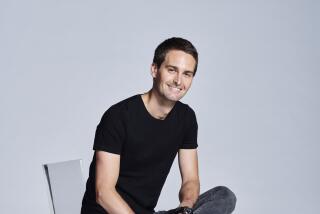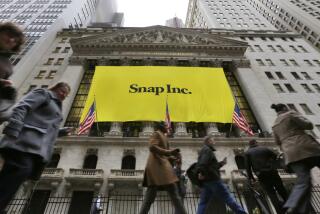Snapchat turns geofilter digital stickers into revenue source
Much of social media involves showing off where we are, whether it’s watching a ballgame at Dodger Stadium, meeting Mickey Mouse at Disneyland or eating a pastrami sandwich at Langer’s.
Now Snapchat Inc., the ubiquitous social media app among teens, has found a way to capitalize on those location brags.
The nearly 100 million daily users of the Venice start-up’s app chronicle their lives through photos and videos that automatically disappear after viewing. The images can be personalized in a variety of ways, including with geofilters, a special location-based overlay.
They bear the name of places along with a symbolic drawing — think beads in New Orleans, dogs at Runyon Canyon Park or skyscrapers in downtown Los Angeles. Introduced a year ago, the colorful digital stickers now decorate more than 1 million posts a day.
Snapchat is hoping to turn these location-centric digital stickers into its second source of revenue by enticing businesses to make their own geofilters — for a fee. On Monday, McDonald’s became the first to sponsor a geofilter; customers at any U.S. location can adorn their Snapchat posts with an illustration of a double cheeseburger and an overflowing pouch of fries, among other options.
Companies with big advertising budgets, whether fast-food chains, theaters or retailers, will be the initial focus of these sponsored geofilters. Like it does with video ads, Snapchat and businesses collaborate on the design.
“Snapchat is about storytelling and geofilters are a fun, visual way for Snapchatters to tell their friends where they are and what they’re up to,” Snapchat spokeswoman Mary Ritti said.
As social media apps including Instagram, Pinterest and Twitter experiment with ways to generate revenue, Snapchat’s geofilter move is a clever one, essentially disguising advertising as a fun and whimsical add-on for users. As such, Snapchat and advertisers hope geofilters will be less intrusive and more effective.
Jerry Shen, senior marketing manager for the Pasadena-based Blaze Pizza chain, said he is intrigued by the possibilities because Snapchat is a powerful way to connect with teenagers and young adults.
“Capabilities in the social space like geofilters, that help us to authentically connect with our fans, will absolutely be an opportunity that we explore,” he said.
Snapchat has been operating off more than $1 billion in venture capital amassed over four years, but it began running ads in October to get on the moneymaking track. So far, it’s mostly been in the form of 10-second video ads, which appear as a commercial break in between user-generated and professional content.
The additional content and the interspersed advertising are part of Snapchat Chief Executive Evan Spiegel’s broader growth strategy to move the company beyond a simple messaging platform. The 25-year-old has said he wants the app to be part of everything young people do on their phones, which could include listening to music and playing games.
Snapchat declined to reveal the cost and duration of McDonald’s sponsored geofilter, but it charges businesses $20 per 1,000 views of video ads on the app. McDonald’s didn’t respond to requests for comment. Paid-for stickers will be distinguished with a tiny “Sponsored” imprint.
Dane Gonzalez, a 21-year-old Snapchat user, said it’s “obvious” that people will want to use business geofilters. Many photos on Snapchat, such as posts of Starbucks coffee cups, already include logos, he noted.
In December, Snapchat launched a website for anyone to propose and design a geofilter and define the area where it should be available. The company, which has five of its 330 employees working on day-to-day geofilter tasks, approves one-third of submissions based on quality and formatting guidelines.
Half of Snapchat’s several thousand geofilters are user-generated. California has 500 geofilters alone, including an LAX sticker for Los Angeles International Airport that’s used 5,000 times per day. There are also geofilters for special events, like the one available Monday in Miami as Jeb Bush announced his candidacy for president.
Gonzalez spent 10 hours in April designing a geofilter for his little-known Central Valley hometown of Hanford.
“Bigger cities will have multiple geofilters, and when you know your town doesn’t have one, it validates we don’t really matter,” he said. “I didn’t want that.”
He said skeptics undervalue Snapchat, whose reputed valuation exceeds $15 billion, and how an item as simple as a geofilter “can brighten up” someone’s day. The stickers add character to posts while serving as a source of civic pride.
Gonzalez gave the word “Hanford” a paintbrushed look to resemble a rustic business sign. He sketched facades of a downtown theater, auditorium and ice cream shop. And he placed a green lawn in front, signifying agriculture as the 55,000-person city’s foundation.
Four days later, he awoke to messages from friends who had screenshotted or were praising his work of art.
“I can’t tell you how many people — dozens and dozens, crazy amounts — were so excited that Hanford finally had a Snapchat geofilter,” Gonzalez said. “It’s touched so many more lives than anything I’ve done.”
The New Orleans geofilter is so popular that 20-year-old creator Juan Pablo Madrid said suburban residents complain that their neighborhoods are outside the boundaries for using it.
To add a geofilter, users swipe several times to the right after taking a photo or video. Location-tracking must be turned on, so the app knows which ones to make available.
Even so, users said they wouldn’t find sponsored geofilters creepy in the way they do ads that automatically appear on Facebook based on their interests and characteristics. They see geofilters as a more creative way to share location than other social apps allow.
Timothy Sehn, Snapchat’s vice president of engineering and the man who came up with the firm’s geofilter concept in January 2014, has devoted nearly his entire Twitter feed to encouraging people to submit their own geofilters. Seeing the strong demand, Snapchat is ready to make geofilters a more integral part of its business.
Tim Hickle, a digital marketing manager at branding firm MilesHerndon, said many businesses will want to advertise through geofilters.
Viewing friends’ Snapchat messages from cool places already entices people to visit, and “taking that from text to a creative sticker could be that extra boost that turns it into a traffic-driving machine,” said Hickle, who helped design a geofilter that is available in Indianapolis.
And he sees an opportunity for geofilters to eventually become a purchasing tool that could command even more businesses’ attention.
“You see a friend post at a show tonight and with two taps, you buy a ticket to tomorrow’s show,” Hickle said. “There is a lot of unexplored potential for geofilters to help people locate things they didn’t even know where there.”
Twitter: @peard33
Times staff writer Andrea Chang contributed to this report.
More to Read
Inside the business of entertainment
The Wide Shot brings you news, analysis and insights on everything from streaming wars to production — and what it all means for the future.
You may occasionally receive promotional content from the Los Angeles Times.











